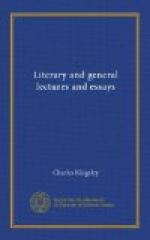When in the daily service of our Church we repeat these words of the sublime hymn ("The noble army of martyrs praise Thee!"), I wonder sometimes whether it be with a full appreciation of their meaning? whether we do really reflect on all that this noble army of martyrs has conquered for us? Did they indeed glorify God through their courage, and seal their faith in their Redeemer with their blood? And if it be so, how is it that we Christians have learned to look coldly upon the effigies of those who sowed the seed of the harvest which we have reaped?—Sanguis martyrum semen Christianorum! We may admit that the reverence paid to them in former days was unreasonable and excessive; that credulity and ignorance have in many instances falsified the actions imputed to them; that enthusiasm has magnified their numbers beyond all belief; that when the communion with martyrs was associated with the presence of their material remains, the passion for relics led to a thousand abuses, and the belief in their intercession to a thousand superstitions. But why, in uprooting the false, uproot also the beautiful and the true?
Thoroughly and practically convinced as we are of the truth of these words, it gave us some pain when, in the work of a very worthy person, “The Church in the Catacombs,” by Dr. Maitland (not the author of “The Dark Ages"), we found, as far as we could perceive, a wish “to advance the Protestant cause,” by throwing general doubt on the old martyrologies and their monuments in the Roman catacombs. If we shall have judged hastily, we shall be ready to apologise. None, as we have said before, more firmly believe that the Protestant cause is the good cause; none are more reverentially inclined toward all honest critical investigations, more anxious to see all truth, the Bible itself, sifted and tested in every possible method; but we must protest against what certainly seems too contemptuous a rejection of a mass of historic evidence hitherto undoubted, except by the school of Voltaire; and of the hasty denial of the meaning of Christian and martyrologic symbols, as well known to antiquaries as Stonehenge or Magna Charta.
At the same time, Dr. Maitland’s book seems the work of a righteous and earnest man, and it is not its object, but its method, of which we complain. The whole question of martyrology, a far more important one than historians generally fancy, requires a thorough investigation, critical and historical; it has to be done, and especially just now. The Germans, the civil engineers of the intellectual world, ought to do it for us, and no doubt will. But those who undertake it must bring to the work, not only impartiality, but enthusiasm; it is the spirit only, after all, which can quicken the eye, which can free the understanding from the idols of laziness, prejudice, and hasty induction. To talk philosophically of such matters a man must love them; he must set to work with a Christian sympathy,




